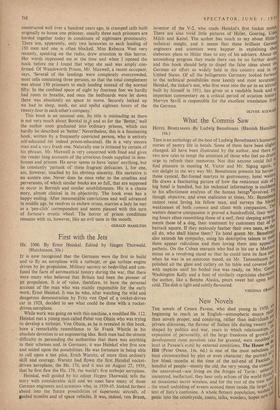First with the Jets
HE. 1000, By Ernst Heinkel. Edited by Itingen Thorwald. (Hutchinson, 30s.)
IT is now recognised that the Germans were the first to build and to fly an aeroplane with a turbojet, or gas turbine engine driven by jet propulsion. Military secrecy so bedeviled and con- fused the facts of aeronautical history during the war, that there were many who believed that Britain had been the pioneer of jet propulsion. It is of value, therefore, to have the personal account of the man who was mainly responsible for the early work, Ernst Heinkel. It was he who, after watching the wild and dangerous demonstration by Fritz von Opel of a rocket-driven car in 1928, decided to see what could be done with a rocket- driven aeroplane.
While work was going on with this machine, a modified He. 112, Heinkel met a young man called Pabst von Ohain who was trying to develop a turbojet. Von Ohain, as he is revealed in this book, bore a' remarkable resemblance to Sir Frank Whittle in his absolute devotion to an engineering idea. Both men had the utmost difficulty in persuading the authorities that there was anything in their schemes and, in Germany, it was Heinkel who first saw and seized upon the possibilities. He was fortunate in being able to call upon a test pilot, Erich Warsitz, of more than ordinary skill and courage. Warsitz had flown the first Heinkel rocket- driven aeroplane, the He. 176, and it was on August 27, 1939, that he first flew the He. 178, the world's first turbojet aeroplane.
Heinkel, well guided by his editor Jiirgen Thorwald, tells the story with considerable skill and we meet 'here many of those German engineers and scientists who, in 1939-45, looked farthest ahead into the future possibilities of supersonic aircraft, of guided missiles and of space vehicles. It was, indeed, von Braun,
inventor of the V-2, who made Heinkel's, first rocket motor. There are also vivid little pictures of Hitler, Goering, Udet, Mitch and Keitel. The author has much to say about HitlerS technical insight, and it seems that these brilliant German engineers and scientists were happier in explaining their elaborate plans to Hitler than to any of his advisers. About the astonishing progress they made there can be no further doubt, and this book should help to dispel the false ideas about the German air effort so widely held in this country and in the United States. Of all the belligerents Germany looked forward to the technical possibilities most keenly and most accurately. Heinkel, the tinker's son, who first went into the air in an aircraft built by himself in 1911, has given us a readable book and as important commentary on a critical period of aviation history Mervyn Savill is responsible for the excellent translation from the German. OLIVER STEWAgl


































 Previous page
Previous page